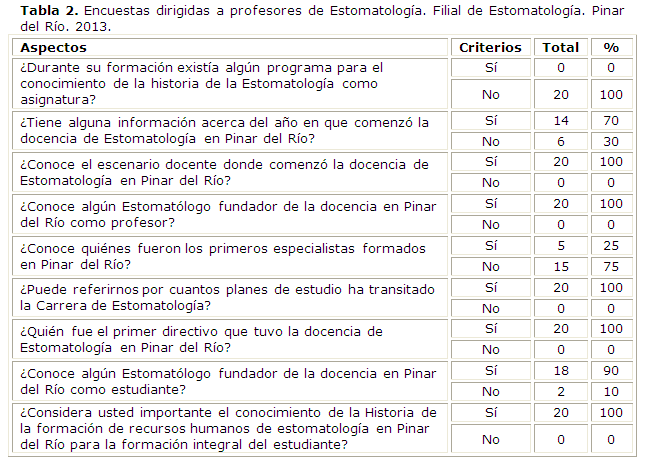Historical knowledge of Pinar del Río dentistry: necessity for a teaching material as a bibliographical complementation
Keywords:
History of Dentistry, Dental education.Abstract
Introduction: Cuban Higher Education centers its attention towards training professional capable of directing their performance profile with initiative, flexibility and autonomy, starting from the integration of knowledge, skills, motivation, and values expressed in their performance. The limiting component of the syllabus design for the subject History of Dentistry and the textbook, not including the elements of the university local context, motivated this research.Objective: to determine the limiting aspects existing in regard to the teaching material used in the learning process of the subject History of Dentistry in the D Syllabus Plan.
Material and method: cross-sectional descriptive research using diverse methods: materialistic-dialectical, historic and logical analysis and empirical ones. Papers were reviewed, surveys were conducted, and experts were interviewed for their evaluations. The results were analyzed by means of descriptive statistics.
Results: the second and fourth years Dentistry students showed lack of knowledge in more than 80% of the surveyed, regarding the history of human resources training in Dentistry in Pinar del Río Province. The total 100% considered important to know the development of such training and coincided in the idea that the teaching materials and bibliography are needed to acquire these knowledge.
Conclusions: the existing literature is insufficient for the study of the local referents in the training of human resources in Dentistry, and it has been proposed to elaborate a teaching material for the subject History of Dentistry, which describes the history of human resources training in Pinar del Río from1959 to 2013.
Downloads
References
1. Mugarra Romero CG, Pérez Rodríguez H, Bujardón Mendoza A. Consideraciones sobre la educación en valores a través de los medios de enseñanza-aprendizaje. Rev Hum Med [Internet]. 2011 Dic [citado 2014 Mayo 23]; 11(3): [Aprox 40 p.]. Disponible en: http://scielo.sld.cu/scielo.php?script=sci_arttextpid=S1727-81202011000300009lng=es
2. Castro Ruz F. Discurso pronunciado en la inauguración del curso escolar 1997-1998. Granma. 4 Set 1997; p 2.
3. Lafaurie OY. Garrido LL. Figueredo LR, Cossio FR. Fransisco GJ. El trabajo educativo y la extensión universitaria en las ciencias médicas. Manual metodológico. La Habana: Editorial Ciencias Médicas; 2009. p. 6.
4. Plan de estudio de la Carrera de estomatología-C Perfeccionado. La Habana: UCM.CH. Facultad de Estomatología CH, 2007.
5. Alarcón Ortiz R. La calidad de la educación superior cubana: retos contemporáneos. Conferencia Inaugural en el Congreso Pedagogía 2013. Publicación del Palacio de las Convenciones La Habana: Palacio de las Convenciones; 2013.p. 9.
6. Fernández Sacasas JÁ. El principio rector de la Educación Médica cubana Un reconocimiento a la doctrina pedagógica planteada por el profesor Fidel Ilizástigui Dupuy. Educ Med Super[Internet]. 2013Jun [citado 2014Mar02];27(2): [Aprox. 9 p.]. Disponible en: http://scielo.sld.cu/scielo.php?script=sci_arttextpid=S0864-21412013000200011lng=es
7. Ministerio de Salud Pública. Reglamento para la organización del proceso docente educativo en los centros de Educación Médica Superior. La Habana: MINSAP; 1988.
8. Cuba. MINSAP. Modelo del Profesional para la formación de estomatólogos Plan de estudios "D". La Habana: MINSAP; 2010.
9. Lave J, Packer M. Hacia una ontología social del aprendizaje. Revista de Estudios Sociales. [Internet]. 2011 Agos [citado 2014Mar02];40: [Aprox. 22 p.]. Disponible en: http://dialnet.unirioja.es/descarga/articulo/3696762.pdf
10. Carrizo Estévez JD. La Universidad del siglo XXI y la formación de recursos humanos en salud. Revista Congreso Universidad [Internet]. 2012 [citado 2014 May 23]; 1(2): [Aprox. 12 p.]. Disponible en: http://www.congresouniversidad.cu/revista/index.php/congresouniversidad/article/viewFile/75/61
11. Ramírez Skinner H. ¿Y antes de Fauchard qué? La odontología en las cavernas, los templos, los hospitales y las universidades. Rev. Clin. Periodoncia Implantol. Rehabil. Oral [Internet]. 2012 Abr [citado 2014 Mayo 23]; 5(1): [Aprox. 20 p.]. Disponible en: http://www.scielo.cl/scielo.php?script=sci_arttextpid=S0719-01072012000100006lng=es
12. De la Mella Quintero S, Mirabal Díaz J, Contrera Pérez J. Factores motivacionales que influyeron en estudiantes de primer año para elegir la carrera de Estomatología. EDUMECENTRO [Internet]. 2013 [citado 2014 May 23]; 4(3): [Aprox. 20 p.]. Disponible en: http://www.revedumecentro.sld.cu/index.php/edumc/article/view/200
13. Trujillo Saínz ZC, Guerra Pando JA, Henríquez Trujillo D. El examen estatal, referencia de utilidad en la labor metodológica del colectivo de Carrera en la especialidad de Estomatología. Rev Ciencias Médicas[Internet]. 2012 Jun [citado2013Abr04]; 16(3): [Aprox. 18 p.]Disponible en: http://scielo.sld.cu/pdf/rpr/v16n3/rpr19312.pdf
14. Fernández Sacasas JÁ. El principio rector de la Educación Médica cubana Un reconocimiento a la doctrina pedagógica planteada por el profesor Fidel Ilizástigui Dupuy. Educ Med Super [Internet]. 2013 Jun [citado 2014 Mayo 27]; 27(2): [Aprox. 18 p.]Disponible en: http://scielo.sld.cu/pdf/ems/v27n2/ems11213.pdf
15. Salas Perea R, Salas Mainegra A. La educación médica cubana. Su estado actual. Revista de Docencia Universitaria [Internet]. 2012 Oct [citado 2014 May 27]; 10 (Número especial): [Aprox. 33 p.]Disponible en: http://red-u.net/redu/index.php/REDU/article/view/477

Published
How to Cite
Issue
Section
License
Authors who have publications with this journal agree to the following terms: Authors will retain their copyrights and grant the journal the right of first publication of their work, which will be publication of their work, which will be simultaneously subject to the Creative Commons Attribution License (CC-BY-NC 4.0) that allows third parties to share the work as long as its author and first publication in this journal are indicated.
Authors may adopt other non-exclusive license agreements for distribution of the published version of the work (e.g.: deposit it in an institutional telematic archive or publish it in a volume). Likewise, and according to the recommendations of the Medical Sciences Editorial (ECIMED), authors must declare in each article their contribution according to the CRediT taxonomy (contributor roles). This taxonomy includes 14 roles, which can be used to represent the tasks typically performed by contributors in scientific academic production. It should be consulted in monograph) whenever initial publication in this journal is indicated. Authors are allowed and encouraged to disseminate their work through the Internet (e.g., in institutional telematic archives or on their web page) before and during the submission process, which may produce interesting exchanges and increase citations of the published work. (See The effect of open access). https://casrai.org/credit/


